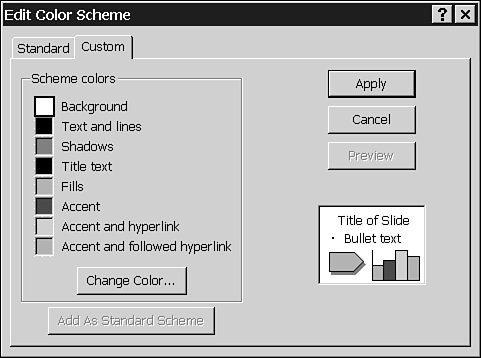Using Color Schemes
A color scheme (see Figure 30.10) consists of eight colors, one for each major type of element in a presentation. Each of PowerPoint's ready-made color schemes consists of foreground and background colors that work well together.
Figure 30.10. A color scheme has eight defining colors.

The problem is that sometimes you don't want the colors to work together all that well. From time to time, a little bit of clash can be a good thing. For example, the color schemes that ship with PowerPoint can be very soothing when applied to text and backgrounds. But when you have a chart on the screen, you want the bars to stand apart from each other: The viewer should be able to tell at a glance where one data bar ends and another begins.
Further, you can use color schemes to subtle advantage. You don't have to be as obvious as, say, setting off your competitor's product specs in red, while showing your product's specs in green. But choosing a high-contrast color for your product and a washed-out, low-contrast color for your competitor can have an impact.
You can create your own color schemes by using any colors that your video settings will support (refer to Figure 30.10 and see Table 30.3).
Just as you can change any detail on a master slide, you can change the colors in the current presentation by changing the color scheme of any master. PowerPoint saves color schemes along with the design; if you apply a new design, PowerPoint discards any previous color changes and applies the color scheme from the new design to your presentation.
PowerPoint uses colors from the color scheme in many different places. For example, the Background dialog box (refer to Figure 30.8) offers colors from the current color scheme as its first choice.
Choosing a New Color Scheme
To apply a color scheme to your presentation:
Apply the design you want. Then choose View, Master, Slide Master to go into Slide Master view.
Click the Design button on the Formatting toolbar, and choose Color Schemes. You'll see the Edit Color Scheme dialog box shown in Figure 30.11.
Figure 30.11. Standard color schemes vary depending on the design.

Choose from among the color schemes offered on the Standard tab, or click the Custom tab (shown earlier in Figure 30.10) to create your own scheme. Select the scheme you want, and then click Apply.
Note
To save a color scheme, click the Add As Standard Scheme button on the Custom tab. From that point on, the new scheme shows up on the Standard tab.
The Standard color schemes for a presentation are saved with the masters. Thus, if you create a new Standard color scheme, and save it as a Design Template or Presentation, that Standard color scheme will be available whenever you apply the design to a different presentation.
Changing Colors on Selected Slides
If you decide you need to change one color on a slide—perhaps it clashes with a picture or doesn't contrast enough with a chart—you might want to consider changing the entire color scheme for that slide.
The procedure for changing the color scheme for a single slide is nearly identical to the procedure outlined in the preceding section. Just select the slide you want to change before starting with step 1. In step 3, be careful to click Apply, and not Apply to All.
Copying a Color Scheme
It's easy to create, store, and modify color schemes; use the Standard color scheme technique described in the preceding two sections. Unfortunately, it's difficult to copy a color scheme from one presentation to another, or from one design to another. That can pose a problem if you want to use the same color scheme (or a group of color schemes) across many different designs—for example, if your company (or your boss) prefers a specific set of colors. You can re-create the color schemes manually in each design or presentation, but the process is time-consuming and error-prone.
Fortunately, there is an undocumented method for transferring a color scheme from one presentation (or design) to another:
Open or create a presentation with at least one slide that contains the color scheme you want to copy. Call this slide the "from slide." Click the Slider Sorter icon to switch to Slide Sorter view.
Open the presentation to which you want to transfer the color scheme. Call this the "to presentation." Switch to Slide Sorter view in this presentation, too.
Click the "from slide," and then click the Format Painter icon on the Standard toolbar.
Bring up the Edit Color Scheme dialog (refer to Figure 30.10) by choosing Design on the Formatting toolbar, clicking Color Scheme on the Slide Design pane, and then clicking Edit Color Scheme. The custom settings you will see match the color scheme on the "from slide."
Click the Add As Standard Scheme button on the Custom tab. Flip over to the Standard tab and verify that the "from slide" color scheme is now a Standard color scheme for this slide.
Click the Apply to All button so that this new Standard color scheme will be applied to the Slide Master. The "to presentation" now has a copy of the "from slide" color scheme.
You can then save the presentation (or its design) by choosing File, Save, or File, Save As.
If you want to restore the original formatting to the "to presentation," open the Slide Master, bring up the Edit Color Scheme dialog box, and click the first Standard color scheme.
